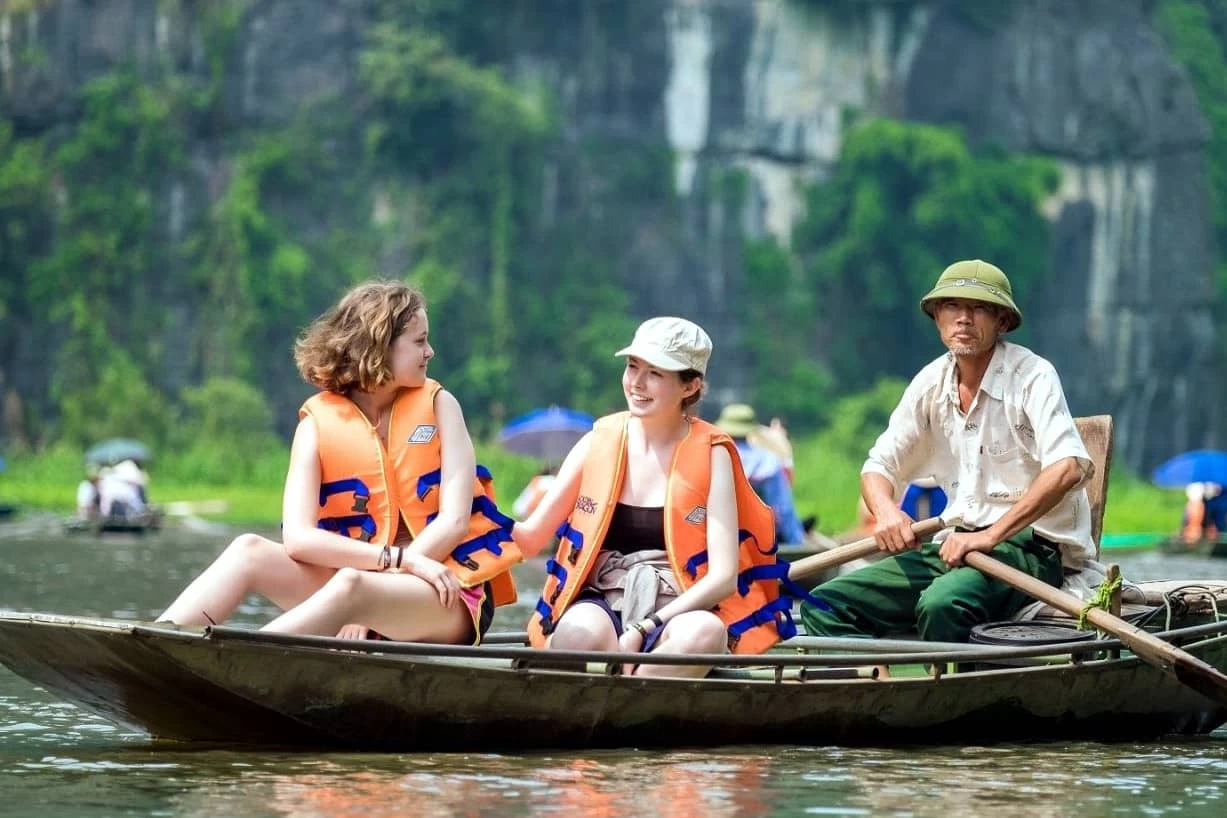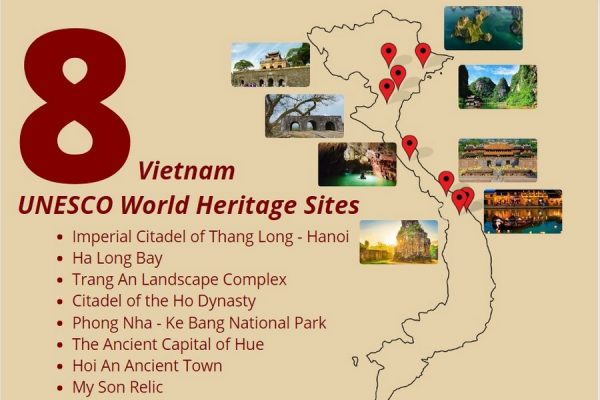
8 World Heritage Sites in Vietnam
Vietnam is a country rich in culture and history with 8 World Heritage Sites in Vietnam recognized by UNESCO. These heritage sites not only reflect the majestic natural beauty of places such as Ha Long Bay with its thousands of fascinating limestone islands or Phong Nha-Ke Bang with its extensive cave system, but also deeply mark history and culture through sites like the Hue Imperial City, Hoi An Ancient Town, and My Son Sanctuary. Each world heritage site in Vietnam is a vivid testament to the process of developing and preserving traditional cultural values. Let’s explore with Ula Travel today!
1. Ha Long Bay- 1 of World Heritage Sites in Vietnam
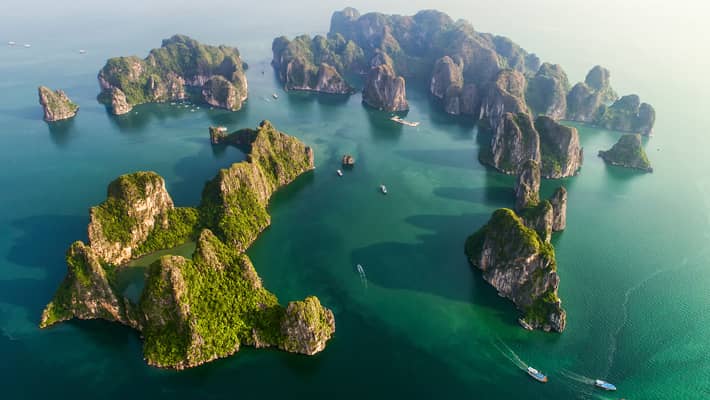
Ha Long Bay the first World Heritage Site in Vietnam
Ha Long Bay, a million-year-old historical landmark, was designated as a UNESCO World Natural Heritage landmark in both 1994 and 2000. Ha Long Bay, with its unique and breathtaking beauty features, is a major draw for tourists and a major economic engine for Quang Ninh.
Ha Long Bay covers an area of approximately 1,553 km2, including 1,969 islands, both named and unnamed. The core zone of the bay spans 334 km2 with over 775 islands, most of which are typical karst limestone islands
The bay’s landscape is characterized by the diverse shapes of Ha Long’s limestone islands, with the patterns and colors of the rocky mountains blending harmoniously with the sea and sky to create a magnificent ink-wash painting, especially at dawn and dusk.
Ha Long Bay is beautiful in all seasons, each bringing its own unique charm, which is why the “Bay of the Descending Dragon” continually attracts tourists from both within and outside the country all year round.
Each year, Ha Long Bay welcomes over 4 million visitors, contributing one-third of the local tourism revenue. However, this development also poses challenges, with the bay facing negative impacts from industrial development, mining, urbanization, and tourism activities.
Visitors to the “new natural wonder of the world,” Ha Long Bay, can also admire many other “wonders” with unique and distinctive beauty, such as the fascinating limestone caves found only in Ha Long Bay: Sung Sot Cave, Thien Cung Cave, Trinh Nu Cave, Dau Go Cave, Me Cung Cave, Ti Top Island, Ba Trai Dao Beach, and Bai Chay—the bay’s most beautiful beach.
In addition, there are additional secluded spots like Mat Rong that are only accessible by speedboat, kayak, or yacht. These small, pristine beaches and coves are dispersed around the bay.
Start your journey with: Halong Bay Tours
2. Central Sector of the Imperial Citadel of Thang Long
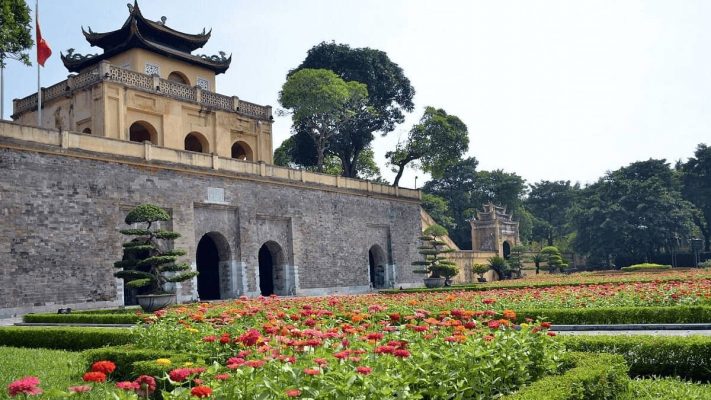
Central Sector of the Imperial Citadel of Thang Long
The Imperial Citadel of Thang Long is one of the most prominent monument complexes in Vietnam’s relic system. This vast architectural achievement was built over several centuries by various emperors and is inextricably linked to the history of Thang Long, now Hanoi.
The Thang Long Imperial Citadel excavation is one of the largest in Vietnamese and Southeast Asian archaeology. Despite the passage of time, the vestiges of Thang Long Citadel may still be discovered in the Central Sector of Thang Long’s Imperial Citadel.
Due to its exceptional historical, cultural, and scientific values, the Central Sector of the Imperial Citadel of Thang Long–Hanoi was designated as a special national relic in 2009 and inscribed on the UNESCO World Heritage List during the grand celebration of the 1,000th anniversary of Thang Long-Hanoi (1010–2010).
See more: Hanoi Tours
3. Citadel of the Ho Dynasty
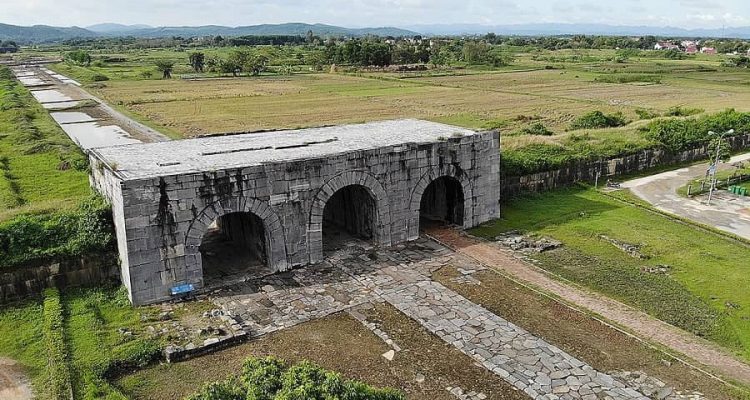
Citadel of the Ho Dynasty
As the capital of the Ho dynasty, the Citadel of the Ho Dynasty was constructed by Ho Quy Ly in 1397, also known as Tay Do to distinguish it from Dong Do (Thang Long, Hanoi).
After its completion, Ho Quy Ly relocated the capital from Thang Long to Tay Do. The citadel was surrounded by stone walls on all four sides, with a total stone volume of approximately 20,000 m2 and nearly 100,000 m2 of earth excavated for construction.
The Citadel of the Ho Dynasty was built on an area of 155 hectares (core zone), with the entire complex covering 5,000 hectares. It consisted of three main sections: La Thanh, Hao Thanh, and Hoang Thanh, with stone construction on the exterior and primarily earthwork on the interior.
The use of large stone blocks demonstrated the organizational strength of a Neo-Confucian state, and the shift in the main axis made the design of the Citadel of the Ho Dynasty distinct from Chinese standards.
In every aspect—architecture, history, culture, or archaeology—the Citadel of the Ho Dynasty radiates its own brilliance. It served as a hub for cultural exchange between Vietnam and East and Southeast Asian countries and played a unique role in implementing the reforms of the Ho dynasty, contributing to the promotion and enhancement of new ideological trends in Vietnam and the region.
Today, the Citadel of the Ho Dynasty stands as a testament to its historical significance and intrinsic value, rightfully earning its place on the world stage as a UNESCO World Heritage Site. After more than 600 years of existence and enduring the vicissitudes of history, on June 27, 2011, at the 35th session of the World Heritage Committee in Paris, France, the Citadel of the Ho Dynasty (Thanh Hoa) was officially inscribed on the World Heritage List as a cultural and natural heritage site.
4. Trang An Landscape Complex
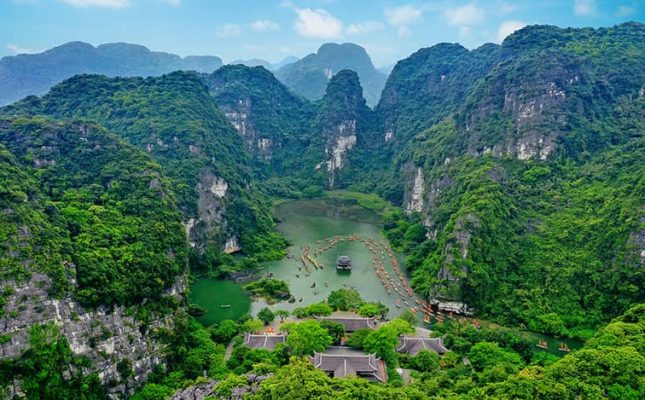
Trang An Landscape Complex
In 2014, the Trang An Landscape Complex (Ninh Binh) was recognized by UNESCO as a World Cultural and Natural Heritage Site due to its outstanding global values.
Situated approximately 100 km south of the capital Hanoi and 7 km west of downtown Ninh Binh along Trang An Avenue, the Trang An Landscape Complex spans over 2,000 hectares. It includes the Trang An Eco-tourism Site at the central location, the Tam Coc-Bich Dong tourist area 8 km to the north, and the ancient capital of Hoa Lu 3 km to the south. These tourist sites are linked by special-use forests, winding rivers, and intertwining valleys.
Surrounded by massive limestone mountains, Trang An harbors rich prehistoric cultural relics that are almost perfectly preserved. It serves as an invaluable repository, demonstrating human interaction and adaptation to environmental changes over thousands of years. Approximately 30 cultural sites within the Trang An cultural landscape have been discovered to date.
Within the Trang An Landscape Complex, there are also hundreds of temples, pagodas, shrines, and architectural structures of religious significance nestled within caves, rocky cliffs, or mountain slopes, harmonizing with the natural scenery and displaying sophisticated architectural techniques.
There are two recognized and classified heritage sites, as well as national scenic spots, with 21 nationally recognized heritage sites and 18 provincially recognized sites existing around limestone valleys and picturesque rivers.
Trang An stands out as a prominent example of human-environment interaction over more than 30,000 years of development in the Southeast Asia region. It is a place of invaluable historical and cultural significance, preserving authentic information about human settlement traditions. It is one of the few places in Southeast Asia that retains its original characteristics without significant human or other external influences.
More Details: Ninh Binh Tours
5. Phong Nha-Ke Bang National Park
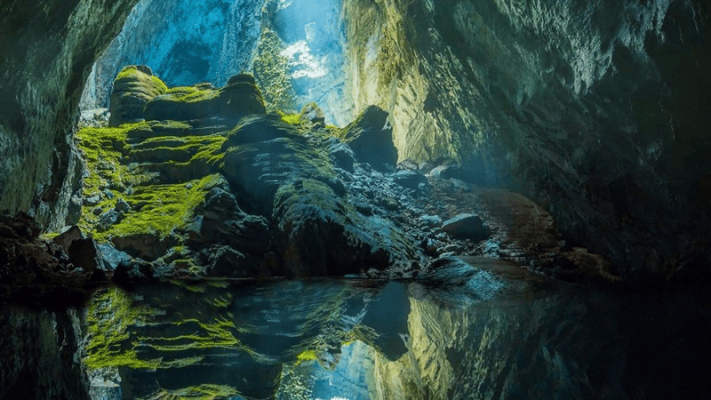
Phong Nha Ke Bang National Park
In 2003, UNESCO recognized Phong Nha-Ke Bang National Park as a World Heritage Site based on geological and geomorphological criteria. Then, on July 3rd, 2015, it was once again acknowledged by UNESCO as a World Heritage Site, this time based on biodiversity criteria.
Phong Nha-Ke Bang National Park is renowned as the “Kingdom of Caves,” with 425 caves in 7 areas or systems (Phong Nha, Nuoc Mooc, Vom, Cha Lo, Tu Lan, Quang Ninh, and Lam Hoa). Among them, Son Doong Cave is evaluated by the British Royal Cave Association as the world’s largest cave; it also hosts the deepest Kast sinkhole in Vietnam (with a depth exceeding 255 meters), potentially the deepest in Southeast Asia.
Moreover, Phong Nha-Ke Bang is a repository of high biodiversity values, boasting 2,953 plant species and 1,394 animal species, many of which are listed in the Vietnam Red Data Book.
Do not miss: Best Day Trip from Hue to Phong Nha
6. My Son Sanctuary
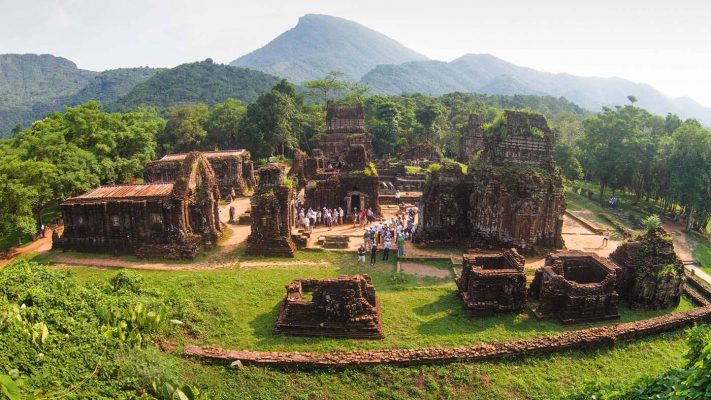
My Son Sanctuary
The My Son Sanctuary is located in Duy Phu commune, Duy Xuyen district, Quang Nam province, approximately 70 km southwest of Da Nang city. Situated within a secluded valley surrounded by majestic mountains in the solemn province of Quang Nam, it was initiated in the 4th century by King Bhadravarman (reigning from 349 to 361) and concluded by the end of the 13th century and early 14th century under the reign of King Jaya Simhavarman III (Che Man).
Discovered in 1885 and recognized by UNESCO as a World Cultural Heritage Site in 1995, The My Son Sanctuary has since become a captivating destination, attracting enthusiasts of cultural exploration.
Within this site, 70 temple tower structures crystallize the historical, cultural, architectural, and artistic values of the Champa civilization, on par with renowned monuments in Southeast Asia such as Borobudur (Indonesia), Pagan (Myanmar), and Angkor Wat (Cambodia).
They epitomize the values of history, culture, architecture, and art established over a span of nine centuries (from the 4th to the 13th centuries). Despite enduring significant damage from time and war, what remains at My Son continues to play an immensely significant role in the world’s historical, cultural, architectural, and artistic heritage.
Though not as grandiose as other Champa archaeological complexes, The My Son Sanctuary still holds a crucial place in Southeast Asian art history as the sole continuous development site in the region for nearly nine centuries.
The architecture of The My Son Sanctuary, refined by ancient Champa artisans, blends architectural techniques and decorative arts to impart an aura of solemnity and mystique to the temple towers.
Learn more about: Discover My Son Sanctuary from Hoi An
7. Hoi An Ancient Town
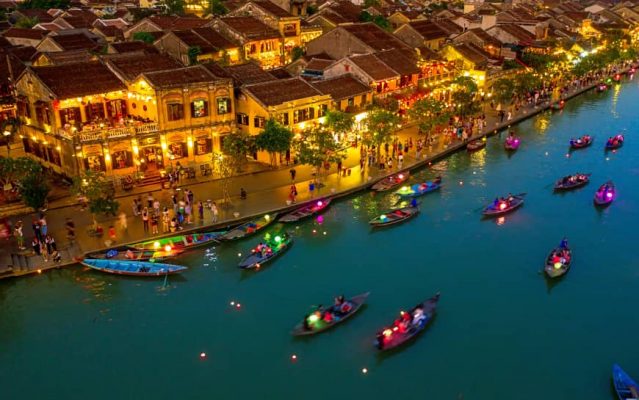
Hoi An Ancient Town
Hoi An Ancient Town is an ancient municipality located in the lower reaches of the Thu Bon River in the coastal plain region of Quang Nam province, Vietnam, about 30 km south of Da Nang city.
Thanks to favorable geographical and climatic factors, Hoi An was once a bustling international trading port where Japanese, Chinese, and Western merchants met during the 17th and 18th centuries.
In 1999, Hoi An Ancient Town was officially recognized by UNESCO as a World Heritage Site. Since then, Hoi An tourism, especially exploring the ancient town, has become a popular destination, attracting a large number of domestic and foreign tourists.
Hoi An Ancient Town is renowned for its traditional architectural beauty and the harmony of ancient houses, walls, and streets. Despite experiencing hundreds of years with many changes, this place still retains its ancient beauty, with moss-covered tranquility on each tile roof, rows of trees…
Today, Hoi An Ancient Town is a particularly unique example of a well-preserved and thoughtful traditional port city in Southeast Asia. Most of the houses here have traditional architecture dating from the 17th to the 19th centuries, lining narrow streets.
Nestled among the row houses are religious architectural works, evidencing the formation, development, and decline of the municipality. Hoi An Ancient Town is also a region marked by cultural blending and exchange. The daily life of the ancient town’s residents, with customs, beliefs, folk arts, and cultural festivals, is still preserved and developed. Hoi An is considered a living museum of urban architecture and lifestyle.
You might be like: Hoi An Tours
8. Complex of Hue Monuments
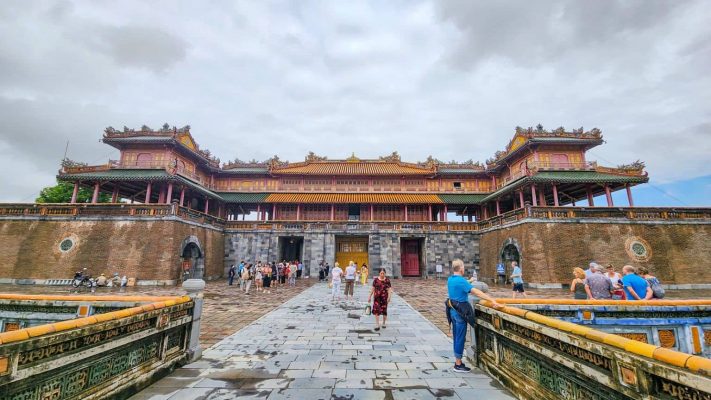
Complex of Hue Monuments
The Complex of Hue Monuments stretches along the banks of the Perfume River in Hue City and some adjacent areas in Thua Thien Hue Province. It served as the cultural, political, and economic center of the province and was the imperial capital of Vietnam under the Nguyen Dynasty from 1802 to 1945.
The architectural ensemble of the Hue Monuments includes a system of relics related to the Nguyen Dynasty, distributed in Hue City and the districts of Huong Tra, Huong Thuy, Phu Vang, and Phu Loc, belonging to Thua Thien Hue Province.
Hue architecture is a unique combination of Vietnamese traditional architecture principles, Eastern philosophical thoughts, and Western military architecture influences, harmonizing with natural elements such as Ngu Binh Mountain, the Perfume River, Giang Vien Islet, Boc Thanh Islet, and Hen Islet. For over a century, it was the capital of a feudal dynasty with a political structure based on Confucianism, once the center of Buddhism. Along with magnificent imperial architectural works, Hue also preserves hundreds of ancient and solemn pagodas, peacefully nestled amidst wild mountains and forests.
Hue‘s great allure lies in its ability to preserve the historical portraits of an imperial capital through numerous historical changes. It conserves a “masterpiece of urban architectural poetry” with hundreds of exquisite, magnificent, diverse, and deeply traditional artistic works, blending into the marvelous landscape of nature with special historical and cultural values.
With its global significance, the Complex of Hue Monuments became Vietnam’s first cultural heritage recognized by UNESCO on the World Heritage List in 1993.
Eight UNESCO World Heritage Sites in Vietnam are not only invaluable treasures representing the country’s natural beauty and rich cultural and historical diversity but also attractive destinations for international tourists. Each heritage contains its own story, from majestic natural wonders like Ha Long Bay and Phong Nha-Ke Bang to outstanding cultural and historical values like Hoi An Ancient Town, My Son Sanctuary, and the Complex of Hue Monuments.
The preservation and promotion of these heritages not only contribute to preserving the national identity but also play a crucial role in sustainable economic and tourism development. These world heritages are Vietnam’s pride, affirming the country’s position on the map of world tourism and culture.
Click here: Hue Tour
In conclusion, Vietnam is a country rich in history, culture, and natural beauty, and its UNESCO World Heritage Sites are a testament to this. These sites are not only significant to Vietnam but also hold global importance, offering visitors a chance to delve into the country’s unique heritage. From ancient towns and imperial citadels to breathtaking landscapes and intricate cave systems, each site tells a story of Vietnam’s past and present, making them must-visit destinations for travelers.
Visiting these sites is not just about sightseeing; it’s about connecting with Vietnam’s soul. Each location provides an opportunity to learn, reflect, and appreciate the country’s contributions to global heritage. Moreover, your visit supports the preservation of these sites, ensuring they remain intact for future generations.
Plan your Vietnam trip today and experience these incredible heritage sites! Whether you’re an adventurer, a history enthusiast, or a culture lover, Vietnam’s UNESCO World Heritage Sites promise unforgettable memories. Don’t wait—start your journey now and discover the wonders that make Vietnam a truly special destination.
See more: Vietnam Travel Packages








